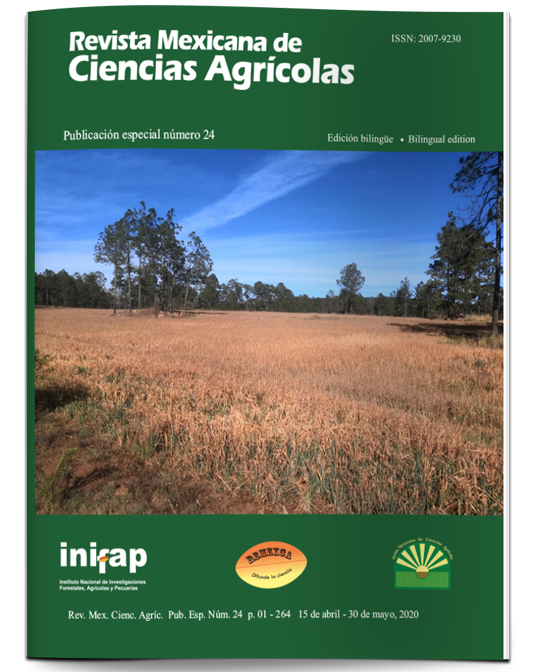Efecto de bacterias PGPB, composta y digestato en el rendimiento de materia seca de pasto ovillo
DOI:
https://doi.org/10.29312/remexca.v0i24.2363Palabras clave:
Bacillus simplex, Brevibacterium frigoritolerans, Dactylis glomerata, Pseudomonas putida, producción de forrajeResumen
El objetivo fue determinar el efecto de composta, digestato y bacterias plant growth-promoting bacteria (PGPB) en la curva de crecimiento, acumulación de biomasa, tasa de crecimiento, altura de planta y unidades soil plant analysis development (SPAD) en pasto ovillo recién establecido, bajo condiciones de invernadero. Los tratamientos fueron: digestato (60%), composta (10% en base seca del suelo), bacterias: Brevibacterium frigoritolerans, Bacillus simplex, Pseudomonas putida, control positivo (fertilización con triple 17) y el control negativo (suelo sin fertilización). Se utilizó un diseño experimental completamente al azar, la unidad experimental fue una maceta con diez tallos de pasto ovillo, con cuatro repeticiones por tratamiento. Los valores más altos (p< 0.05) de materia seca (6.4 g MS maceta), tasa de crecimiento (0.15 g MS maceta d-1) y altura de forraje (18.3 cm) se registraron en el tratamiento con composta; donde el rendimiento final de materia seca superó 200% al testigo negativo. El tratamiento con digestato evidenció valores inferiores a los obtenidos con composta, pero superó al resto de los tratamientos. Las mejores bacterias PGPB fueron Pseudomonas putida y Bacillus simplex que superaron el rendimiento de materia seca 25 y 37% con respecto a Brevibacterium frigoritolerans y al control negativo, respectivamente. Las bacterias PGPB pueden ser una alternativa de fertilización ya que el rendimiento de materia seca fue mayor que con el control negativo y se igualó al rendimiento obtenido con fertilización química; sin embargo, los dos fertilizantes orgánicos (composta y digestato) favorecieron el mayor rendimiento de materia seca.
Descargas
Descargas
Publicado
Cómo citar
Número
Sección
Licencia
Los autores(as) que publiquen en Revista Mexicana de Ciencias Agrícolas aceptan las siguientes condiciones:
De acuerdo con la legislación de derechos de autor, Revista Mexicana de Ciencias Agrícolas reconoce y respeta el derecho moral de los autores(as), así como la titularidad del derecho patrimonial, el cual será cedido a la revista para su difusión en acceso abierto.
Los autores(as) deben de pagar una cuota por recepción de artículos antes de pasar por dictamen editorial. En caso de que la colaboración sea aceptada, el autor debe de parar la traducción de su texto al inglés.
Todos los textos publicados por Revista Mexicana de Ciencias Agrícolas -sin excepción- se distribuyen amparados bajo la licencia Creative Commons 4.0 atribución-no comercial (CC BY-NC 4.0 internacional), que permite a terceros utilizar lo publicado siempre que mencionen la autoría del trabajo y a la primera publicación en esta revista.
Los autores/as pueden realizar otros acuerdos contractuales independientes y adicionales para la distribución no exclusiva de la versión del artículo publicado en Revista Mexicana de Ciencias Agrícolas (por ejemplo incluirlo en un repositorio institucional o darlo a conocer en otros medios en papel o electrónicos) siempre que indique clara y explícitamente que el trabajo se publicó por primera vez en Revista Mexicana de Ciencias Agrícolas.
Para todo lo anterior, los autores(as) deben remitir el formato de carta-cesión de la propiedad de los derechos de la primera publicación debidamente requisitado y firmado por los autores(as). Este formato debe ser remitido en archivo PDF al correo: revista_atm@yahoo.com.mx; revistaagricola@inifap.gob.mx.
Esta obra está bajo una licencia de Creative Commons Reconocimiento-No Comercial 4.0 Internacional.



